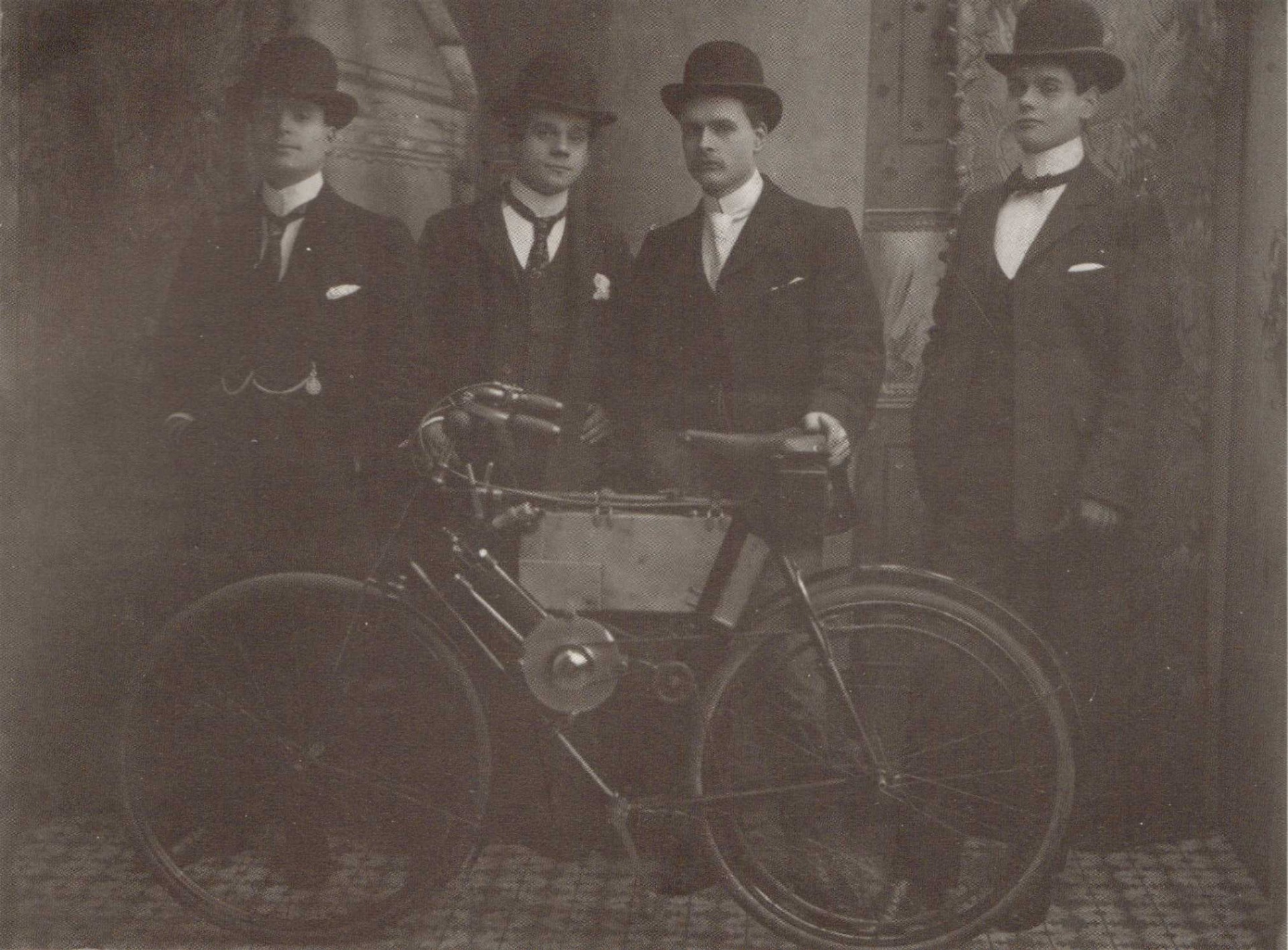
Early Beginnings
Click here for go back to the main "History" page
The story of AJS really starts with Joe Stevens, an engineer who owned the "Stevens Screw Company Ltd", in Wednesfield, near Wolverhampton. The business had a reputation for quality engineering and in time his sons Harry, George, Albert John ('Jack'), and Joe Stevens Junior, joined the business.
In 1899 the four Stevens brothers set themselves up in business producing petrol engines for various uses, trading as the "Stevens Motor Manufacturing Company". Harry soon became interested in motor vehicles and fitted an old "Mitchell engine to a BSA bicycle". Although the engine was unreliable, the machine was a great success.
The brothers are pictured below in 1900 with the Mitchell powered BSA.


The machine came to the attention of William Clark, the owner of the Wearwell Motor Carriage Company Limited. Wearwell already made bicycles and Clark realised that to make a powered machine all that was needed was an engine and a few modifications.
Wearwell's were customers of Joseph Stevens & Company, so an agreement was reached that Stevens would supply a number of engines each week, which would be fitted to heavy duty bicycles. The first Wearwell-Stevens motor bicycle appeared in 1901. It was fitted with 2½hp. air-cooled, 4 stroke Stevens engine, with automatic inlet valve, and mechanically operated side exhaust valve. It sold for 42 guineas.
The machine proved popular, an improved version was at the 1902 National Cycle Show at Crystal Palace, the price was reduced to £40, and orders poured in. Further changes were made in 1903.
During 1903 the Stevens brothers also produced a one-off Stevens motorcycle, the first motorcycle to be completely designed and built by them. Their sister, Lily Stevens was the first person to ride the machine and became Wolverhampton's first lady motorcyclist.

Lily's younger sisters Ethel and Daisy also rode the machine. Ethel was only 14 years old at the time. One day whilst riding the machine up Darlington Street, a policeman stopped her and asked if she had a license. She pretended to be her elder sister and later produced Lily's license at the police station.
1903 also saw the introduction of a modified version of the bicycle. The front wheel was replaced with a two-wheeled axle, onto which an upholstered wicker seat was attached. The machine sold for 53 guineas. A conversion for two wheeled machines was available for £16.5s.0d. Unfortunately both of these products proved to be unpopular.
The 'Motette' with Harry Stevens as passenger is pictured below. Photo courtesy of the late Geoff Stevens.

Stevens' engines continued to sell extremely well and a wide range of new models soon became available. In February 1904, both of the Stevens' companies, J. Stevens and Company, and the Stevens Motor Manufacturing Company moved to Fort Works, at the end of Pelham Street. The companies then joined together to form the Stevens Motor Manufacturing Company Ltd, registered on 10 December, 1904 with Joseph Stevens senior, George Stevens, Harry Stevens, as three of the six shareholders.
An advert from 'The Motor' 28th March, 1905 is below.

All went well until summer 1905 when a slump in the motor industry led to a fall in sales of engines. This continued for some time. To safeguard the screw and rivet part of the business, Stevens Screw Company Ltd was formed in 1906, which moved to premises in Retreat Street. The company was run by Joseph Stevens senior, and daughters, Lily and Daisy. Brothers George, Joe, and Jack Stevens found other jobs until things improved and the company could support them again.
During this time the brothers designed and developed a new range of engines in readiness for the end of the depression. From 1907 Stevens also made around 500 engines for the Australian motorcycle manufacturer Lewis.
Wearwell sales were still going well and as the range of machines increased, so did the range of engines designed by Stevens. Harry also designed a new type of cork inserted clutch, available as an extra. The machines sold from 37 to 42 guineas's
New versions of the 'Motette' were also produced, available as passenger and commercial types. The machines used 4½hp. or 5hp. water-cooled vertical twin engines, with a 2 speed gearbox and clutch and sold for 75 guineas. The heavier versions were built like a car with a steering wheel and body. They used a 7hp. or 8hp. water-cooled, vertical twin engine, a 3 speed gearbox with clutch, and sold for 100 or 105 guineas.
The engine below was developed for use in light cars. The advert includes a testimonial written by George A. Barnes of Lewisham, "I have succeeded in climbing Westerham Hill three times in succession with an 11 stone 7lb passenger. This is the only single-geared Fore-car that has ever accomplished this difficult task."

However whilst Wearwell-Stevens motor bicycles continued to sell, it was not enough to keep the engine business going. A receiver was appointed on 17 March, 1907.
Things improved in 1908 when Clyno started to produce motorcycles using Stevens engines. Right from the start they sold well and the future seemed brighter.
Disaster struck at Wearwell in 1909 when it was discovered that the Company Secretary, Mr. King, had pilfered a large sum of the company's money, resulting in Wearwell going into liquidation.
Despite the contract to produce engines for Clyno, after the demise of Wearwell, the brothers decided they should produce their own motorcycle, which they named using the initials of the only brother to have two Christian names, Albert John, and so AJS was born.
Much of the information throughout these history pages is taken from "Wolverhampton History and Heritage Website". Most of the pages on that website relating to AJS were produced by Bev Parker with the assistance of Geoff Stevens.
For more Information about the "Early beginnings" see
The Stevens Motor Manufacturing Company (historywebsite.co.uk)